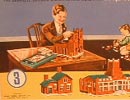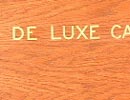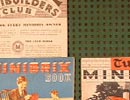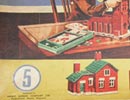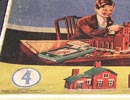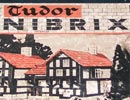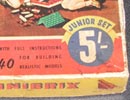
Development
Malcolm Hanson
The range of parts was increased in 1936 and the sets were revised accordingly. The new parts included balustrades, corinthian pillars, double angle bricks and universal pins. The roofs were now made from rubber sheets. In addition the young modeller was now able to buy rubber base plates on which to construct his or her models. As the attractive new coloured instruction manual gave full details of the models the blueprints were now rendered obsolete. The firm extended its advertising efforts at this point with advertisements appearing in such prestigious journals as the Meccano Magazine, Boy's Own Paper and the Children’s Newspaper. Several major display models were also built. These included models of the Guild Hall at Portsmouth; Dr Scholl's Foot Appliance factory; a cathedral; Selfridges (which was displayed in the shop itself); and, most famously of all, Buckingham Palace. This latter model weighed 205 lb, measured 67.5in x 24.5in x 16.5in and used 13,611 standard components. It was used at important trade fairs and appeared for many years on the back cover of the instruction manual. After the war, at the time of Queen Elizabeth’s coronation, the model was renovated, fitted with electric lighting and a model of the coronation coach and again used for advertising purposes.
On July 23rd 1936 Minibrix came to Royal attention in a rather surprising way. The Queen Mother, then the Duchess of York, was due on that day to lay the foundation stone for the Princess of York Hospital for sick children in Banstead Wood, Surrey. A plan had already been conceived to raise money for the project with the help of Minibrix. People attending the laying of the foundation stone could pay 1/- towards the building fund and this entitled them to place a 'mini-brick' on a Minibrix model of the hospital. Dick Bennets, draughtsman for I.T.S., who drew the blue prints for the original sets, even made a Minibrix version of the foundation stone to put on the model. When the day came for the Duchess to lay the real foundation stone the weather was so appalling that it was deemed too wet for Her Royal Highness to perform the ceremony in the open. Instead she laid the Minibrix foundation stone on the Minibrix model and then signed her name as the first person to lay one of the model bricks! A replica of the model foundation stone was then auctioned for 125 guineas and within one hour £700 had been raised for the hospital fund from the sale of bricks. Although the firm were not allowed to refer to this event in their advertising, Arnold Levy produced an internal document describing what took place and an article about the occasion appeared in the trade journal 'Games & Toys'.
The Queen Mother, then the Duchess of York, laid the Minibrix foundation stone on the Minibrix model and then signed her name as the first person to lay one of the model bricks!
A significant innovation in early 1937 was the introduction of 'Tudor Minibrix’ a distinct but compatible system of three sets with two conversion sets. The bricks were white and black and cleverly manufactured to allow half-timbered structures incorporating diagonal bracing beams to be made. The roofs were constructed from individual rubber tiles, which locked together according to the same principle as the bricks and were supported by purlins. These tiles came in brown or green. Those included in the Tudor sets were brown but a new range of supermodels, pictured in the new standard manual, included models using the green tiles. The purlins came in a large range of lengths and in two distinct cross-sections to match the ordinary and double angle bricks. Initially the purlins were wooden, but later they were manufactured from a rigid ebonite rubber. The instruction manual included convincing models of such famous Tudor residences as Ann Hathaway's cottage and the Old Moot Hall in Aldeburgh. A top of the range ‘De Luxe Combination Set’ was also introduced at this time which for 147/- gave the lucky owner a standard No.7 set, a Tudor No.3 set and a 14in x 21in base plate, all together in an oak cabinet with a lift out tray.
In common with many constructional toys of the time a club, the Minibuilders Club, was set up to encourage keen modellers. Members received a badge, a certificate, a special, triangular section Minibrix pencil and an occasional newsletter called the 'Minibuilders Bulletin’. In addition a prize of 5/- was offered for any model design sent in that was later published in a manual.
Initially Minibrix had been distributed by C. Giles & Co of London. However, by March 1937 it was announced to the trade that due to the ever increasing popularity of the product the Premo Rubber Company was going to enlarge its sales organisation and take over distribution themselves. But this move seems to have been a failure and by February of the following year Minibrix were being distributed by Dean & Son Ltd of Ludgate Hill.
No further changes to the system itself took place before the war despite the fact that some had been planned. In 1938 patents had been applied for covering two interesting items that never actually went into production. One was for a ‘corbel’, which is the technical name for a supporting piece that projects from a wall to take the weight of a structure such as a balcony. The other was for a brick, which had a channel instead of the usual holes to receive lugs. As well as this function, the more important purpose of the channel was to receive a bar. This bar could be used to form an arch and brickwork could then be built above it. Both these, but especially the latter, would have proved useful additions to the system and why they were never actually produced remains a mystery.
In fact the only other pre-war changes were minor ones. The standard set boxes changed to a basic yellow colour with attractive illustrations of models on the lid. The Imperial Cabinet was introduced in about 1940. This set consisted of a standard No.6 set with a Tudor No.2 and an 14in x 2in base plate in an oak cabinet. From about the same time Minibuilders could purchase an empty De Luxe set cabinet to store their collection for the sum of 30/-
By 1940 Maxibrix Cubes had been introduced. These were not parts of the Minibrix system proper but were 1” cubes of rubber intended as safe playthings for babies. They came in 6 different 'fast' colours and a box of 36 cubes cost 6/9.
As the war started prices of sets and parts, which had been held for the past five years, increased slightly in common with most manufactured goods.

